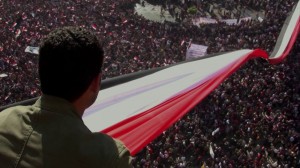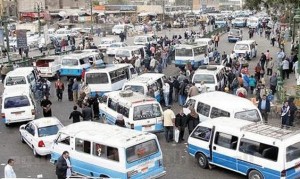 Cairo Drive (Sherief Elkatsha, Egypt, 2013, 77 min)
Cairo Drive (Sherief Elkatsha, Egypt, 2013, 77 min)
Wisconsin Film Festival, April 8, 6:30pm & April 9, 3:45pm»
Cairo Drive captures the streets of Cairo, Egypt from 2009, before the first Egyptian revolution, to 2012, around the first presidential election. This documentary is the third by Sherief Elkatsha, whose previous work similarly focused on Egyptian society. The film has a humorous and playful tone, but still successfully hits on many serious issues. It effectively conveys Cairo’s struggles by having them played out on the intersections of the streets.
The film is successful because it shows the effects of the revolution on people’s daily lives by focusing on one common annoyance: traffic. But traffic merely stands in for the bigger and more complex societal problems. No matter the person, everyone is affected by the chaotic streets. The unruly traffic is a reflection of the complex state of the country—a symptom that the citizens believe will go away after the current government recedes. Throughout these years, the documentary revisits many of the same characters, who vary in age, occupation, gender, but the thing they have in common is that they hate the traffic. Everyone hates the traffic, and this is obvious by the constant honking, swearing, crashes, and references to Frogger.
 Some of the traffic jams captured are like intricate, lawless puzzles and it is difficult to imagine how they came to be. Some cars are sticking into the sides of others, some are facing the opposite direction and two-lanes soon become three-lanes or three into four. The streets are riddled with totaled cars, people aimlessly walking through them. The repeated images of crashes and wrecked vehicles reminded me of Godard’s Week-End (1968), and Cairo Drive has that similar absurd undertone that Week-End has, where everyone is acting chaotically and all systems have been thrown out the window.
Some of the traffic jams captured are like intricate, lawless puzzles and it is difficult to imagine how they came to be. Some cars are sticking into the sides of others, some are facing the opposite direction and two-lanes soon become three-lanes or three into four. The streets are riddled with totaled cars, people aimlessly walking through them. The repeated images of crashes and wrecked vehicles reminded me of Godard’s Week-End (1968), and Cairo Drive has that similar absurd undertone that Week-End has, where everyone is acting chaotically and all systems have been thrown out the window.
Everyone offers different opinions about the underlying cause of the traffic. One man believes microbuses cause the hold up since the drivers will do anything to pick up a passenger holding money. Another man believes that the slow tuk-tuks, motorized rickshaws, cause the problems. A woman blames the lack of laws or any kind of system. A few solutions are also proposed, including a creative one by a government official who suggests creating a generation that will understand driving. His plan would give up on the current drivers and focus on young children by teaching them songs to learn that red means stop and green means go.
During the span of the film we witness how each of the characters’ opinions shift in the midst of change. While the laws are altered and riots and celebrations pass, the characters’ responses to their environment change as well. Despite these changes, there is little difference in the state of the streets. After the police leave, pedestrians willingly replace them to direct traffic, which does suggest a possible improvement. But soon the pedestrians leave, and the police are needed again as the traffic gets worse. At this point, some start to argue that the revolution was a mistake. When vehicles are side by side and everyone is irritated, the streets become an arena for political debate. For instance, after a woman drives up next to a bus, she starts up an argument with an old man who is exposed by the bus’s open doors. He is against the revolution and thinks that it is worthless. She counters, “I think it has changed but it will take time to feel.”
There are points of this film where the pace is slowed and certain ideas become repetitive. The slightly unique, colorful style is not interesting enough to hold attention during these slower moments. Yet, overall it was very effective for the filmmaker to use something so relatable and so universally irritating as traffic to convey how large scale political changes affect the daily lives of the people. By capturing a vital period in history, through the perspective of workers, rebellious teens, policemen and even those who have lost friends and family in the insane streets, Elkatsha’s final product is a very impressive piece of work.